- With standard equipment
- With safety pack
Find more information in the General Comments section of the assessment
Find more information in the Rating Validity tab of the assessment
- See More
- See More
- See More
- See More
- Good
- Adequate
- Marginal
- Weak
- Poor
 Passenger
Passenger
 Driver
Driver
 Rear Passenger
Rear Passenger
 Driver
Driver
 Car
Car
 Pole
Pole
 Rear Seat
Rear Seat
 Front Seat
Front Seat
- Good
- Adequate
- Marginal
- Weak
- Poor


Passenger
outboard
Fitted to the vehicle as standard
Not fitted to the test vehicle but available as option
Not Available
-
i-Size CRS
-
ISOFIX CRS
-
Universal Belted CRS
Easy
Difficult
Safety critical
Not allowed
| Seat Position | |||
|---|---|---|---|
| Front | 2nd row | ||
| Passenger | Left | Right | |
| Maxi Cosi 2way Pearl & 2wayFix (rearward) (iSize) | |||
| Maxi Cosi 2way Pearl & 2wayFix (forward) (iSize) | |||
| BeSafe iZi Kid X2 i-Size (iSize) | |||
| Maxi Cosi Cabriofix & FamilyFix (ISOFIX) | |||
| BeSafe iZi Kid X4 ISOfix (ISOFIX) | |||
| Britax Römer Duo Plus (ISOFIX) | |||
| Britax Römer KidFix XP (ISOFIX) | |||
| Maxi Cosi Cabriofix (Belt) | |||
| Maxi Cosi Cabriofix & EasyBase2 (Belt) | |||
| Britax Römer King II LS (Belt) | |||
| Britax Römer KidFix XP (Belt) | |||
Easy
Difficult
Safety critical
Not allowed
In the frontal offset test, protection of both the 6 year and 10 year dummy was good or adequate. However, in the side barrier test, the head of the 10 year dummy contacted the metal frame of the folding roof and protection was rated as poor, based on the resulting high decelerations. The C-Class Cabriolet automatically disables the front passenger airbag when a rearward-facing child restraint is positioned there. Mercedes-Benz showed that the system worked robustly and it was rewarded. Care is needed when installing the Group I ISOFIX restraint in the rear seats as the top tether anchorage is obscured. Otherwise all of the seats for which the car is designed could be installed and accommodated without problem.
- Good
- Adequate
- Marginal
- Weak
- Poor

Head Impact 21.0 Pts
Pelvis Impact 0.8 Pts
Leg Impact 6.0 Pts
The C-Class Cabriolet has an 'active' bonnet. Sensors detect when a pedestrian has been struck and actuators raise the bonnet to provide greater clearance to the stiff structures in the engine compartment. Mercedes-Benz showed that the system worked robustly for different pedestrian statures and over a wide range of speeds, so tests were conducted with the bonnet in the raised position. Results were good at almost all test locations. The bumper provided good protection to pedestrians' legs and maximum points were scored in these tests. However, protection of the pelvis was predominantly poor. A pedestrian-detecting autonomous braking system is available. However, as this is an option it was not tested as part of this assessment.
- Good
- Adequate
- Marginal
- Weak
- Poor
| System Name | Speed Limiter |
| Speed Limit Information Function | N/A |
| Warning Function | Active braking (no warning necessary) |
| Speed Limitation Function | Manually set (accurate to 5km/h) |
| Applies To | All seats | ||
| Warning | Driver Seat | Front Passenger(s) | Rear Passenger(s) |
| Visual | |||
| Audible | |||
|
|||
| System Name | Active Brake Assist | |||
| Type | Forward Collision Warning with Auto-Brake | |||
| Operational From | 10 km/h | |||
| Additional Information | Default On; Supplementary Warning | |||
| Performance | | ||||
| Autobrake Function Only | Driver reacts to warning | |||
| Operational Speed | 10-80 km/h | 10-80 km/h | ||
| Approaching a stationary car | See AEB City | Crash avoided up to 45km/h.Crash speed reduced up to 60km/h. | ||
| Approaching a slower moving car | Crash speed reduced up to 70km/h. | Crash speed reduced up to 80km/h. | ||
| Following a car at short distance | ||||
| Car in front brakes gently | Mitigation | Mitigation | ||
| Car in front brakes harshly | Mitigation | No reaction | ||
| Following a car at long distance | ||||
| Car in front brakes gently | Mitigation | Mitigation | ||
| Car in front brakes harshly | Mitigation | Mitigation | ||
A driver-set speed limiter and a seatbelt reminder for the front and rear seats are fitted as standard. Also standard is the autonomous emergency braking system. Tests of this system at highway speeds demonstrated adequate performance. A lane assistance system is available as an option but is not included in this assessment.
- Specifications
- Safety Equipment
- Videos
- Advanced Rewards
- Rating Validity
Specifications
Tested Model Mercedes-Benz C 220d Cabriolet, LHD
Body Type - 2 door Cabriolet
Year Of Publication 2017
Kerb Weight 1745kg
VIN From Which Rating Applies - all variants from WDD2054862F593831 except some 4x4
Class Large Family Car
Safety Equipment
Note: Other equipment may be available on the vehicle but was not considered in the test year.
Fitted to the vehicle as standard
Fitted to the vehicle as part of the safety pack
Not fitted to the test vehicle but available as option or as part of the safety pack
Not available
Not applicable
Videos
Advanced Rewards
Rating Validity
Variants of Model Range
| Body Type | Engine & Transmission | Model Name/Code | Drivetrain | Rating Applies | |
|---|---|---|---|---|---|
| LHD | RHD | ||||
| 2 door cabriolet | 2.2 diesel | C 220 d Cabrio* | 4 x 2 |
 |
 |
| 2 door cabriolet | 2.2 diesel | C 220 d 4MATIC Cabrio | 4 x 4 |  |
 |
| 2 door cabriolet | 2.5 diesel | C 250 d Cabrio | 4 x 2 |  |
 |
| 2 door cabriolet | 1.8 petrol | C 180 Cabrio | 4 x 2 |  |
 |
| 2 door cabriolet | 2.0 petrol | C 200 Cabrio | 4 x 2 |  |
 |
| 2 door cabriolet | 2.0 petrol | C 200 4MATIC Cabrio | 4 x 4 |  |
 |
| 2 door cabriolet | 2.5 petrol | C 250 Cabrio | 4 x 2 |  |
 |
| 2 door cabriolet | 3.0 petrol | C 300 Cabrio | 4 x 2 |  |
 |
| 2 door cabriolet | 4.0 petrol | C400 4MATIC Cabrio | 4 x 4 |  |
 |
* Tested variant






Find more information in the General Comments section of the assessment
 Share
Share
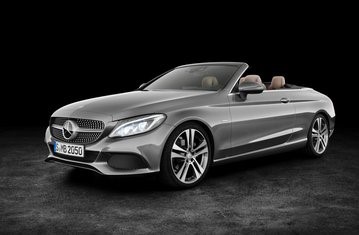
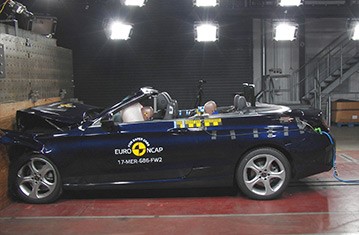
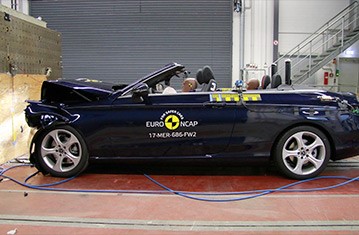
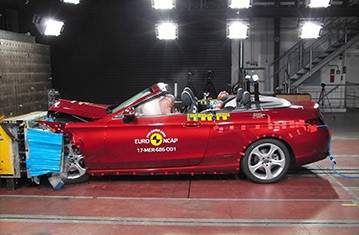
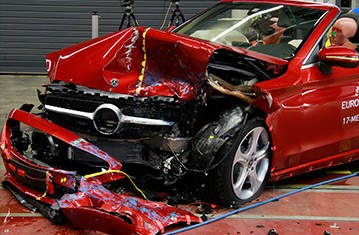
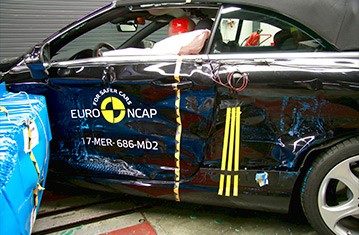
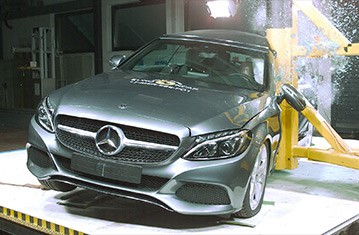
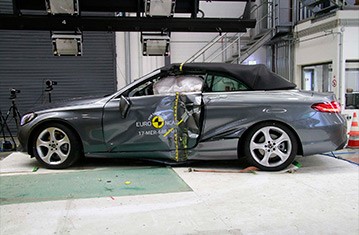



The passenger compartment remained stable in the frontal offset test. Dummy readings showed good protection of the knees and femurs of both driver and passenger. Mercedes-Benz showed that a similar level of protection would be provided for occupants of different sizes and to those sat in different positions. Protection of the passenger was good for all critical body areas. In the full-width rigid barrier test, protection of the driver and rear passenger was good or adequate. In the side barrier test, protection of the dummy was good for all critical body areas and maximum points were scored. However, in the more severe side pole test, dummy readings of rib compression indicated weak protection of the chest. Tests on the front seats and head restraints demonstrated good protection against whiplash injury in the event of a rear-end collision. A geometric assessment indicated weak whiplash protection for occupants of the rear seats. The C-Class Cabriolet has, as standard, an autonomous emergency braking system. Tests showed good performance of the functionality of this system at the low speeds at which many whiplash injuries are caused, with collisions avoided or mitigated.